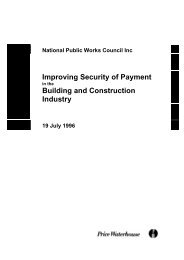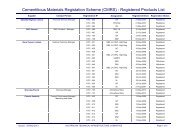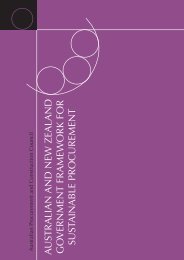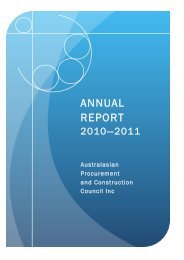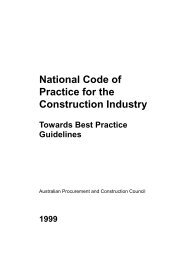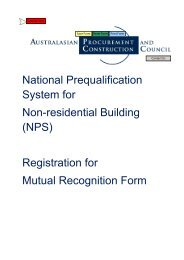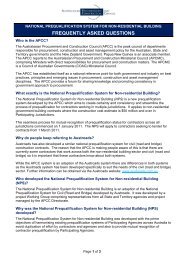(NPS) Guidelines - Australian Procurement and Construction Council
(NPS) Guidelines - Australian Procurement and Construction Council
(NPS) Guidelines - Australian Procurement and Construction Council
Create successful ePaper yourself
Turn your PDF publications into a flip-book with our unique Google optimized e-Paper software.
National Prequalification<br />
System for<br />
Non-residential Building (<strong>NPS</strong>)<br />
<strong>Guidelines</strong><br />
Version November 2012
The National Prequalification System for Non-residential Building (<strong>NPS</strong>) aims to create<br />
certainty <strong>and</strong> consistency, <strong>and</strong> streamline the process of prequalification for contractors<br />
working in multiple jurisdictions. It applies to non-residential government building contracts<br />
where the construction cost estimate is $50 million <strong>and</strong> above in Participating Jurisdictions.<br />
This seamless process for mutual recognition of prequalification status for contractors across<br />
all jurisdictions commenced on 1 January 2011 <strong>and</strong> will be reviewed annually. For details of<br />
participating jurisdictions <strong>and</strong> participating agencies please refer to the APCC website.<br />
NOTE: Commonwealth agencies are unlikely to process prequalification applications. Where a<br />
Commonwealth agency decides to seek tenders from prequalified contractors, it will recognise<br />
relevant prequalification status awarded by States <strong>and</strong> Territories under the APCC National<br />
Prequalification System.<br />
<strong>NPS</strong> Documents<br />
Applicants should access the full set of <strong>NPS</strong> documents before undertaking their applications.<br />
1. <strong>NPS</strong> <strong>Guidelines</strong> (this document)<br />
2. <strong>NPS</strong> Application Form <strong>and</strong> Referee Report (application for prequalification)<br />
3. <strong>NPS</strong> Registration for Mutual Recognition Form (for recognition in multiple jurisdictions)<br />
4. <strong>NPS</strong> Contractor Performance Report (review of performance <strong>and</strong> compliance)<br />
All documents can be downloaded from www.apcc.gov.au<br />
Page 1 of 20
Table of Contents<br />
1. Introduction .................................................................................................................................. 4<br />
1.1. Overview .................................................................................................................................. 4<br />
1.2. Background.............................................................................................................................. 5<br />
1.3. Scope ...................................................................................................................................... 5<br />
1.4. Mutual Recognition .................................................................................................................. 6<br />
2. Conditions of Prequalification .................................................................................................... 7<br />
2.1. General .................................................................................................................................... 8<br />
2.2. No Guarantee of Work ............................................................................................................. 8<br />
2.3. Application Requirements ........................................................................................................ 8<br />
2.4. Confidentiality <strong>and</strong> Exchange of Information ............................................................................ 8<br />
2.5. Change of Circumstances ........................................................................................................ 8<br />
2.6. Requirements for Mutual Recognition ...................................................................................... 9<br />
2.7. The Applicant’s Undertaking .................................................................................................... 9<br />
2.8. Use of Prequalification Status for Advertising <strong>and</strong> Promotion ................................................. 10<br />
3. Prequalification Categories <strong>and</strong> Financial Levels ................................................................... 10<br />
3.1. Overview ................................................................................................................................ 10<br />
3.2. Contract Types ...................................................................................................................... 11<br />
3.3. Financial Levels ..................................................................................................................... 10<br />
4. Prequalification Requirements .................................................................................................. 11<br />
4.1. Eligibility for Prequalification .................................................................................................. 11<br />
4.2 Restrictions ............................................................................................................................. 12<br />
4.3 Assessment Criteria................................................................................................................ 12<br />
5. Assessment Process ................................................................................................................. 14<br />
5.1. Assessment of Applications ................................................................................................... 14<br />
5.2. Notification ............................................................................................................................. 14<br />
5.3. Varying Prequalification Status .............................................................................................. 14<br />
6. Maintenance of Prequalification Status .................................................................................... 15<br />
6.1. Provision of Updated Information ........................................................................................... 15<br />
6.2. Contractor Performance Reports ........................................................................................... 15<br />
6.3. Review of a Contractor’s Prequalification Status .................................................................... 15<br />
6.4. Downgrading, Suspension or Cancellation of Prequalification ................................................ 16<br />
6.5. Effect of a Decision to Downgrade, Suspend or Cancel ......................................................... 18<br />
6.6. Reviews ................................................................................................................................. 18<br />
6.7. Appeals .................................................................................................................................. 18<br />
7. Definitions .................................................................................................................................. 20<br />
Page 2 of 20
1. Introduction<br />
Generally contractors wishing to tender above certain thresholds for non-residential government<br />
building contracts with Commonwealth, State <strong>and</strong> Territory building agencies must be prequalified.<br />
A National Prequalification System for Non-residential Building (<strong>NPS</strong>) commenced on 1 January 2011<br />
<strong>and</strong> will be reviewed annually.<br />
Note: Prior to the commencement of the <strong>NPS</strong> contractors prequalified (for non-residential government<br />
building projects $50 million <strong>and</strong> above) under a local jurisdictional prequalification system were<br />
transitioned to the <strong>NPS</strong> with no effect on their prequalification status for that jurisdiction.<br />
However all such contractors wishing to achieve the benefit of mutual recognition <strong>and</strong> all new entrants<br />
to prequalification will need to apply under the <strong>NPS</strong>.<br />
1.1. Overview<br />
Where prequalification is used as part of the procurement process, Participating Agencies will use the<br />
<strong>NPS</strong> for applications to non-residential government building contracts where the construction cost<br />
estimate is $50 million <strong>and</strong> over, <strong>and</strong> apply it to contractors seeking to tender for contracts for those<br />
projects from 1 March 2011.<br />
This <strong>NPS</strong> covers the building of non-residential government buildings as defined by the <strong>Australian</strong><br />
Bureau of Statistics. This includes hospitals, schools, office buildings, sporting facilities, courts <strong>and</strong><br />
police stations. It does not apply to the construction of civil engineering assets such as roads <strong>and</strong><br />
bridges which are addressed in the companion Austroads National Prequalification System for Civil<br />
(Road <strong>and</strong> Bridge) <strong>Construction</strong> refer: www.austroads.com.au.<br />
Prequalification of contractors is a continuous process of review comprising:<br />
<br />
<br />
<br />
<br />
an initial assessment of a contractor’s technical capabilities <strong>and</strong> financial capacity at the time of<br />
application (including its operational management systems)<br />
financial <strong>and</strong>/or technical checks from time to time<br />
assessment of a contractor’s performance during, <strong>and</strong> at the completion of the contract, <strong>and</strong> at<br />
other times when a review may be warranted<br />
periodic re-assessment <strong>and</strong> renewal of prequalification via submission of updated information<br />
at the discretion of the Assessing Agency.<br />
Eligible contractors prequalified under the <strong>NPS</strong> in one jurisdiction may apply for mutual recognition in<br />
any other jurisdiction at any time.<br />
Eligibility requirements are detailed in these <strong>Guidelines</strong>, along with the conditions of prequalification<br />
<strong>and</strong> the process that will be undertaken by the relevant Participating Agency to assess <strong>and</strong> review<br />
prequalification applications.<br />
Page 3 of 20
1.2. Background<br />
The <strong>NPS</strong> was developed by the Australasian <strong>Procurement</strong> <strong>and</strong> <strong>Construction</strong> <strong>Council</strong> (APCC) in<br />
conjunction with State <strong>and</strong> Territory jurisdictions.<br />
As jurisdictions have their own prequalification requirements <strong>and</strong> processes, the <strong>NPS</strong> was developed<br />
to avoid duplication of effort <strong>and</strong> reduce administrative burden for both agencies <strong>and</strong> contractors.<br />
The APCC acknowledges that the <strong>NPS</strong> is an adaptation of the National Prequalification System for<br />
Civil (Road <strong>and</strong> Bridge) <strong>Construction</strong> developed by Austroads. Where practicable to do so, the APCC<br />
has endeavoured to reflect elements of the Austroads system in the <strong>NPS</strong>.<br />
The intent of the <strong>NPS</strong> is to benefit Participating Agencies <strong>and</strong> contractors by meeting the following<br />
objectives:<br />
<br />
<br />
<br />
<br />
<br />
<br />
<br />
<br />
harmonise prequalification systems of Participating Agencies<br />
provide mutual recognition of contractor prequalification by Participating Agencies<br />
reduce barriers to entry for contractors seeking to tender for non-residential government<br />
building contracts across different jurisdictions<br />
encourage mobility of contractors across State <strong>and</strong> Territory borders<br />
reduce the time <strong>and</strong> cost to contractors applying for prequalification in multiple jurisdictions<br />
reduce red tape<br />
provide for information-sharing on contractor performance across Participating Agencies<br />
reduce the administrative burden on individual Participating Agencies.<br />
1.3. Scope<br />
The scope of the <strong>NPS</strong> has been built upon the following:<br />
<br />
<br />
<br />
<br />
The <strong>NPS</strong> applies only to the Participating Jurisdictions listed in the table at the beginning of<br />
these <strong>Guidelines</strong>. Within these jurisdictions, the <strong>NPS</strong> applies to the government agencies<br />
<strong>and</strong>/or entities required to comply with non-residential building policies <strong>and</strong> prequalification<br />
systems of the relevant Participating Jurisdiction.<br />
Participating Agencies (<strong>and</strong> other government agencies <strong>and</strong>/or entities within their jurisdictions<br />
that would normally use the <strong>NPS</strong>) are not bound to use prequalification in all instances. They<br />
also have the option to use alternative forms of tendering (for example, open tenders or<br />
expressions of interest) for specific contracts.<br />
Participating Agencies will manage the prequalification <strong>and</strong> contractor performance aspects of<br />
the <strong>NPS</strong> within their respective jurisdictions.<br />
While the intent is to maintain contractor prequalification nationally, there may be instances<br />
when a contractor is ineligible to tender in a jurisdiction despite its prequalification status<br />
having been recognised in another jurisdiction due to a lack of compliance with jurisdiction<br />
specific requirements (e.g. local legislation, local policy requirements).<br />
Page 4 of 20
1.4. Mutual Recognition<br />
Parameters of mutual recognition<br />
Mutual recognition under the <strong>NPS</strong> means a contractor’s prequalification status will be recognised<br />
when the contractor seeks to register with any other Participating Agency in another jurisdiction. Key<br />
features of the <strong>NPS</strong> include:<br />
<br />
<br />
contractors prequalified by the Assessing Agency may apply for mutual recognition by any<br />
Participating Agency<br />
mutual recognition by another Participating Agency is a more streamlined process which will<br />
usually only require the prequalified contractor to provide evidence of prequalification with the<br />
Assessing Agency plus minimal information such as company details, a contact person (a local<br />
contact person where applicable) <strong>and</strong> acknowledgement to comply with jurisdiction specific<br />
government requirements <strong>and</strong> legislation.<br />
(For more details, please refer to separate Registration for Mutual Recognition Form, available from<br />
www.apcc.gov.au.)<br />
Note: To be eligible for prequalification or mutual recognition in some jurisdictions a contractor must<br />
hold an appropriate building license as required by the legislation applicable in the jurisdiction.<br />
Exclusions<br />
<br />
Prequalified partnerships, trust arrangements, Public Private Partnerships (PPPs), Private<br />
Financed Partnerships (PFPs) <strong>and</strong> Alliances are not eligible to access the mutual recognition<br />
benefits of the <strong>NPS</strong>, except in the jurisdictions where those entities are currently able to be<br />
prequalified, at the sole discretion of the relevant Participating Agency.<br />
An overview of the Application Process under the National Prequalification System is presented in<br />
Figure 1.<br />
Page 5 of 20
2. Conditions of Prequalification<br />
Figure 1 – Overview of the Application Process under the National Prequalification System <strong>and</strong><br />
Conditions of Prequalification.<br />
Page 6 of 20
2.1. General<br />
Applicants for prequalification <strong>and</strong> prequalified contractors are required to comply with the conditions<br />
<strong>and</strong> associated procedures described in this Section.<br />
2.2. No Guarantee of Work<br />
Prequalification is not to be construed as a guarantee of work or of an invitation to tender.<br />
Prequalification only determines a contractor’s eligibility to tender for work. Participating Agencies<br />
apply relevant jurisdictional procurement principles, including value-for-money, in the assessment <strong>and</strong><br />
selection of tenders.<br />
2.3. Application Requirements<br />
To become prequalified, a contractor (“the Applicant”) must select one or more contract types that it<br />
believes to be commensurate with its capabilities, <strong>and</strong> submit the <strong>NPS</strong> Application Form to the<br />
Assessing Agency.<br />
In submitting an application, the Applicant gives permission to the Assessing Agency to carry out such<br />
investigations as it considers necessary to determine whether the Applicant meets the relevant<br />
prequalification criteria. These investigations may include, but are not limited to, referee reports, a<br />
building licence check where relevant, a company search <strong>and</strong> bank reference checks.<br />
In undertaking the assessment, the Assessing Agency may also take into account other information in<br />
its possession, or information provided by other Participating Agencies or government agencies.<br />
In considering applications from eligible entities, the Participating Agency reserves the right to<br />
examine the resources of any parent or related entity.<br />
2.4. Confidentiality <strong>and</strong> Exchange of Information<br />
Information submitted in an application for prequalification will be treated as confidential <strong>and</strong> will not<br />
be disclosed to any party outside the Participating Agencies <strong>and</strong> their assessors, unless legally<br />
required to do so, or to obtain legal or financial advice, or as required for the purpose of appeals<br />
regarding prequalification decisions.<br />
The Assessing Agency may refer the Applicant’s documentation to its external assessors for<br />
assessment. External assessors are required to maintain confidentiality of all information received.<br />
In lodging an application, the Applicant agrees to provide the necessary authority to enable searches<br />
<strong>and</strong> enquiries to be carried out.<br />
Once prequalified, the Contractor’s details, including its performance on specific contracts, may be<br />
shared with other Participating Agencies <strong>and</strong> government agencies for the purpose of monitoring<br />
performance <strong>and</strong> to determine continued eligibility for prequalification.<br />
By submitting an application, the Applicant authorises any Participating Agency to gather, monitor,<br />
assess, <strong>and</strong> communicate to other Participating Agencies information about the Applicant’s financial<br />
position <strong>and</strong> its performance for the purposes of administering the jurisdictional roles <strong>and</strong> obligations<br />
under the <strong>NPS</strong>.<br />
2.5. Change of Circumstances<br />
Prequalified contractors have an obligation to advise the Assessing Agency <strong>and</strong> any other<br />
Participating Agency which has recognised their prequalification, without delay, of any change in any<br />
circumstance that may be material to their prequalification status. This includes, but is not limited to,<br />
change of ownership, change of management control (such as company director, company secretary,<br />
key technical personnel) any convictions for breaches of legislation or statutory regulations, changes<br />
in financial status <strong>and</strong> acts of insolvency.<br />
Page 7 of 20
2.6. Requirements for Mutual Recognition<br />
The applicant must indicate its ability <strong>and</strong> intention to comply with any government procurement<br />
requirements, codes regulation or legislation current in the jurisdiction of any Participating Agency in<br />
which the Contractor is registered under the <strong>NPS</strong>. These are listed in the Registration for Mutual<br />
Recognition Form used by each Participating Agency <strong>and</strong> may be amended from time to time.<br />
2.7. The Applicant’s Undertaking<br />
Acceptance of conditions of prequalification<br />
In making an application for prequalification the Applicant is deemed to have accepted the conditions<br />
of prequalification <strong>and</strong> to have acknowledged <strong>and</strong> accepted that these conditions may be varied from<br />
time to time.<br />
1. The Applicant acknowledges that the Assessing Agency will rely upon information provided by<br />
the Applicant in granting prequalification.<br />
2. The Applicant agrees that the Assessing Agency may make enquiries of any person or persons<br />
regarding:<br />
a) the information provided by the Applicant in support of its initial application or any<br />
subsequent application to vary its prequalification status<br />
b) information from any source relating to the Applicant<br />
c) the performance <strong>and</strong> financial st<strong>and</strong>ing of the Applicant.<br />
3. The Applicant agrees to make available to the Assessing Agency, upon request, all necessary<br />
documentation held, or reasonably obtainable, by the Applicant, supporting its initial or any<br />
subsequent application for prequalification.<br />
4. The Applicant agrees that the Assessing Agency may release the Applicant’s prequalification<br />
details, in accordance with section 2.3 of these <strong>Guidelines</strong> to other Participating Agencies,<br />
Participating Jurisdictions or government agencies.<br />
5. The Applicant agrees to participate in performance reporting processes for all government<br />
building projects under the <strong>NPS</strong> on which the Applicant has been contracted. (Please refer to the<br />
separate document, Contractor Performance Report, downloadable from www.apcc.gov.au.)<br />
6. The Applicant accepts that, in the event of entering into a contract with any Participating<br />
Jurisdiction, it will not breach any contractual or legal requirements of the jurisdiction, including<br />
but not limited to:<br />
a) any codes of practice for the building <strong>and</strong> construction industry<br />
b) workplace health <strong>and</strong> safety, industrial relations, workers compensation <strong>and</strong> any<br />
environmental legislation<br />
c) the provisions of any licensing legislation or regulations for the building <strong>and</strong> construction<br />
industry<br />
d) government policies developed from time to time that specifically apply to the building <strong>and</strong><br />
construction industry.<br />
7. The Applicant agrees that it will keep financial records as required by the provisions of the <strong>NPS</strong><br />
<strong>and</strong> that it will provide such records promptly to the Assessing Agency upon request.<br />
8. The Applicant acknowledges that, where prequalification is used as part of the procurement<br />
process, it will only be entitled to tender for non-residential building projects in the jurisdiction(s)<br />
in which it is prequalified under the <strong>NPS</strong>.<br />
Page 8 of 20
9. Any prequalification status accorded shall not be regarded, taken or held out as any warranty or<br />
undertaking as to the performance of the Applicant on any building project nor as any basis for<br />
liability by the Assessing Agency to make payments to the Applicant or any of its suppliers or<br />
subcontractors.<br />
10. The Participating Jurisdictions <strong>and</strong> Participating Agencies give no warranties or undertakings of<br />
any nature to any third party or person external to government by reason of prequalification as to<br />
the Applicant’s competency, ability or fitness to undertake building work of any nature<br />
whatsoever.<br />
11. The Participating Jurisdictions <strong>and</strong> Participating Agencies do not accept any liability for any loss<br />
of any nature whatsoever occasioned by any third party or person acting or refraining from acting<br />
in reliance upon any statement, advice or information in any way connected or associated with<br />
prequalification.<br />
12. A breach of any of these conditions of prequalification may result in the Participating Agency<br />
reviewing, downgrading, suspending, or cancelling the Applicant’s registration.<br />
2.8. Use of Prequalification Status for Advertising <strong>and</strong> Promotion<br />
The Applicant agrees not to use any information relating to its prequalification status or contract<br />
performance in its advertising or promotional material or publish such information in any form.<br />
3. Prequalification Categories <strong>and</strong> Financial Levels<br />
3.1. Overview<br />
Applicants are approved for prequalification based on an assessment of their capacity to undertake<br />
projects of varying technical <strong>and</strong> financial complexity <strong>and</strong> risk.<br />
Applicants may seek to be prequalified for:<br />
a range of contract types (described in the following section 3.2)<br />
<br />
financial limits on the value of non-residential government building contracts where the<br />
construction cost is estimated at $50 million <strong>and</strong> above.<br />
Applicants are required to complete the prequalification matrix on contract types included in the <strong>NPS</strong><br />
Application Form.<br />
Page 9 of 20
3.2. Contract Types<br />
Applicants may seek to be prequalified for one or more of the following contract types. (The term<br />
‘Principal’ refers to the client who awards the contract.)<br />
A. Construct/Construct Only:<br />
The Principal under the terms of the contract provides the contractor with the documentation which<br />
fully describes the work to be undertaken. The contractor then builds the works according to the<br />
project documentation prepared by the principal‘s consultants. The contractor may be responsible for<br />
carrying out some design documentation to the extent specified by the contract. The contract can be<br />
based on a lump sum, a schedule of rates <strong>and</strong> lump sums or bill of quantities.<br />
B. Design <strong>and</strong> Construct:<br />
The Contractor is responsible for all or some of the design, including schematic design, design<br />
development, documentation <strong>and</strong> design coordination, as well as construction.<br />
C. Managing Contractor:<br />
The Managing Contractor may be engaged on a project brief, to commission, manage <strong>and</strong> accept<br />
responsibility for consultants that design the works <strong>and</strong> subcontractors that construct the works. The<br />
Principal may also engage a project manager or project director to manage the Managing Contractor<br />
contract <strong>and</strong> to support <strong>and</strong> advise the Principal. A Managing Contractor contract usually involves the<br />
payment of actual reasonable costs (up to a guaranteed or target construction sum(s), where agreed<br />
for construction work, or a guaranteed price for all the work) plus fees.<br />
D. Design, Construct <strong>and</strong> Maintain:<br />
The Contractor is provided with a project brief, generally including some concept designs <strong>and</strong> the<br />
quality <strong>and</strong> performance requirements of the asset are specified. The Contractor is responsible for the<br />
preparation or completion of the concept design, development of the design, preparation of<br />
construction documentation, construction of the asset <strong>and</strong> maintenance for a specified period (say 10<br />
years). Asset condition monitoring indicators are specified, by which the performance of the completed<br />
asset will be measured during the maintenance period.<br />
E. Relationship:<br />
This contract type includes early contractor (or tenderer) involvement (ECI), <strong>and</strong> relationship contracts.<br />
ECI enables the Principal to effectively work with a contractor to better identify <strong>and</strong> allocate risks prior<br />
to, or as part of, a tender process to establish a fixed contract price. It enables contractors to<br />
commence the pricing phase with a full underst<strong>and</strong>ing of the contract requirements. It also enables the<br />
Principal to monitor contractor performance against Key Performance Indicators (KPIs) <strong>and</strong> effectively<br />
work with the Contractor to resolve issues in advance, settling the price, time <strong>and</strong> other parameters of<br />
the contract. ECI may be an effective early component of all the above contracting types aligned with<br />
cooperative contracting.<br />
3.3. Financial Levels<br />
Applicants should note that each Participating Agency reserves the right to:<br />
<br />
<br />
require an updated financial assessment to be undertaken at any time<br />
impose a financial limit on the value of a contract that can be undertaken by a contractor within<br />
its jurisdiction.<br />
Page 10 of 20
4. Prequalification Requirements<br />
Applicants for prequalification are required to meet eligibility criteria <strong>and</strong> demonstrate sufficient<br />
achievement across the five overarching criteria against which applications are assessed (company<br />
profile, financial capacity, company experience, external client referee reports <strong>and</strong> technical capacity).<br />
4.1. Eligibility for Prequalification<br />
<strong>Construction</strong> companies <strong>and</strong> other legal entities that possess relevant experience in non-residential<br />
building are eligible to apply for prequalification.<br />
Related entities<br />
Prequalification does not extend to related or subsidiary companies or entities of a prequalified<br />
contractor. Any such company or entity must apply for prequalification in its own right.<br />
Joint ventures<br />
Incorporated joint ventures<br />
An incorporated joint venture applying for prequalification must meet the criteria for prequalification in<br />
its own right.<br />
Unincorporated joint ventures<br />
Prequalification applications from unincorporated joint ventures must include:<br />
<br />
<br />
<br />
<br />
a copy of the joint venture agreement<br />
a description of the structure of the joint venture<br />
details of key personnel from each of the joint venture parties <strong>and</strong> their roles <strong>and</strong><br />
responsibilities<br />
details of the management systems to be used by the joint venture.<br />
While it is acceptable to nominate the certified management systems of one of the joint venture parties<br />
for use by the joint venture, a statement should be provided to demonstrate how the system will be<br />
integrated across the group <strong>and</strong> how other joint venture parties will be made familiar with the system<br />
details.<br />
Note: Prequalification of unincorporated joint ventures is at the sole discretion of each Participating<br />
Agency.<br />
4.2. Restrictions<br />
A company acting as trustee for (on behalf of) another are not eligible to apply for prequalification<br />
under the <strong>NPS</strong> in that capacity. However, contractors operating under a trust that were prequalified<br />
with one or more Participating Agencies immediately prior to introduction of the <strong>NPS</strong> on 1 January<br />
2011 will have a four-year grace period to restructure <strong>and</strong> re-apply for prequalification with that<br />
agency. A Trust will need to rearrange their business structure into an acceptable from of legal entity<br />
to remain prequalified. From 1 January 2015, a trust will not be eligible to apply for prequalification<br />
under the <strong>NPS</strong>.<br />
In the case where a company is partly or fully owned by a trust, however operates in its own right <strong>and</strong><br />
has sufficient unencumbered assets in it, such company is eligible to apply for prequalification under<br />
the <strong>NPS</strong>.<br />
Page 11 of 20
4.3 Assessment Criteria<br />
Applications for prequalification will be assessed against the four criteria listed below.<br />
1. Company profile<br />
The Applicant’s organisational capacity will be assessed to determine its suitability for prequalification,<br />
including the following areas:<br />
<br />
<br />
<br />
organisational structure<br />
stability of organisation<br />
senior management.<br />
2. Technical capacity<br />
The Applicant must demonstrate that it has the technical capacity to undertake contracts using the<br />
particular contract types covered in these <strong>Guidelines</strong> <strong>and</strong> in the Application Form.<br />
In particular, the Applicant must have:<br />
<br />
<br />
<br />
evidence of appropriately qualified key personnel<br />
evidence of relevant licences to practice<br />
third party certified <strong>and</strong>/or jurisdictional second party (acceptance of second party will be at the<br />
sole discretion of the Participating Agency) certified management systems for quality<br />
management, occupational health <strong>and</strong> safety <strong>and</strong> environmental management.<br />
Where third party certification or verification of a management system is required, the third party<br />
certification organisation must be accredited, to the relevant st<strong>and</strong>ard, by the Joint Accreditation<br />
System for Australia <strong>and</strong> New Zeal<strong>and</strong> (JAS-ANZ).<br />
3. Company experience<br />
The Applicant must be able to demonstrate successful completion of at least two contracts in the last<br />
three years in the contract type for which they are seeking prequalification. The maximum contract<br />
capacity will be based on the highest value of any successfully completed contract.<br />
The Applicant must provide a minimum of two external client referee reports for each contract type on<br />
completed projects to demonstrate experience <strong>and</strong> capability in the type of work relevant to the<br />
particular contract type. The details of the external client referee reports are covered in the<br />
accompanying document, the <strong>NPS</strong> Application Form.<br />
In addition, the Applicant’s demonstrated experience in the following areas will be assessed to<br />
determine suitability for prequalification:<br />
<br />
<br />
<br />
project management<br />
relationship management<br />
management systems.<br />
Page 12 of 20
4. Financial capacity<br />
To be considered for prequalification <strong>and</strong> to maintain prequalification status, applicants must<br />
demonstrate strong business viability. However, any jurisdiction-specific builder’s licensing financial<br />
requirements <strong>and</strong> associated prequalification requirements will take precedence over these<br />
requirements for that jurisdiction. Applicants must produce externally audited (ASIC Certificate of<br />
Registration) accounting statements for the last three years.<br />
The following criteria for financial capacity will be assessed to determine suitability for <strong>NPS</strong><br />
prequalification.<br />
The Applicant (the legal entity seeking <strong>NPS</strong> prequalification) must have:<br />
a) as a minimum, a current ratio of 1<br />
b) net tangible assets that are not less than 5% of the Applicant’s average previous three<br />
years’ financial turnover<br />
The maximum financial capacity will be based on the lesser of the following:<br />
a) 100% of the Applicant’s average previous three years’ financial turnover<br />
b) 10 times working capital<br />
In calculating the above financial criteria <strong>and</strong> maximum financial capacity, assets <strong>and</strong> liabilities will be<br />
allowed where it can be demonstrated that they can be relied upon for the purpose of supporting the<br />
entity in the event of default or insolvency (at the sole discretion of the Assessing Agency). Examples<br />
of these assets <strong>and</strong> liabilities may include all contingent assets, all shareholder loans, all related entity<br />
loans <strong>and</strong> all related entity investments.<br />
However, under the financial requirements of Queensl<strong>and</strong>’s Prequalification (PQC) System for building<br />
industry contractors related entity loans <strong>and</strong> investments are excluded from net tangible assets. Other<br />
exclusions are detailed at:<br />
http://www.works.qld.gov.au/downloads/bpu/contractor_pqc_finreq.pdf. In this context<br />
prequalification under the <strong>NPS</strong> in Queensl<strong>and</strong> will be limited by the particular requirements of<br />
Queensl<strong>and</strong>’s PQC System.<br />
In the case where an Applicant is assessed by Queensl<strong>and</strong>, <strong>and</strong> the Applicant has requested mutual<br />
recognition by other jurisdictions, the <strong>NPS</strong> financial assessment criteria will apply for the purposes of<br />
mutual recognition.<br />
In some cases, a Participating Agency may allow mutual recognition where the Applicant provides a<br />
letter of undertaking or acceptable Deed of Company Guarantee from a related or other company in a<br />
form approved by the Participating Agency. The requirement <strong>and</strong> nature of the letter of undertaking or<br />
Deed of Company Guarantee will be at the sole discretion of each Participating Agency.<br />
The rules applicable to calculating net tangible assets apply to the calculation of working capital.<br />
Determining Maximum Contract Value<br />
The maximum contract value for which the Applicant will be prequalified to tender will be determined<br />
on the basis of the lesser of:<br />
the highest value of any successfully completed contract – as per Criterion 3; <strong>and</strong><br />
the contractor’s financial capacity – as per Criterion 4.<br />
Page 13 of 20
5. Assessment Process<br />
5.1. Assessment of Applications<br />
The Assessing Agency will assess each application for prequalification to determine whether it meets<br />
the requirements of the prequalification category or categories <strong>and</strong> financial levels sought by the<br />
Applicant. Applicants will cooperate with internal <strong>and</strong> external assessors, including other government<br />
agencies.<br />
Applicants will only be considered for prequalification for the types of work, <strong>and</strong> values, appropriate to<br />
their demonstrated experience <strong>and</strong> capacity.<br />
Assessment of applications will be based on the following:<br />
<br />
<br />
<br />
<br />
information contained in the completed Application Form <strong>and</strong> attached supporting<br />
documentation, together with any additional information sought by the Assessing Agency from<br />
the applicant<br />
external client referee reports undertaken by a referee independent from the Applicant <strong>and</strong><br />
based on the st<strong>and</strong>ard template provided in the <strong>NPS</strong> Application Form<br />
documented evidence held by the Assessing Agency regarding the Applicant’s previous<br />
performance<br />
information available from other Participating Agencies or government agencies regarding the<br />
Applicant’s previous performance.<br />
The Assessing Agency may consider any information in the assessment as it deems necessary.<br />
5.2. Notification<br />
Applicants will be notified in writing of the outcome of their application for prequalification.<br />
5.3. Varying Prequalification Status<br />
A prequalified contractor may apply for a variation of its prequalification status at any time by<br />
completing <strong>and</strong> submitting a new Application Form. This includes Contractors wishing to upgrade their<br />
prequalification status. The application must be lodged with the original Assessing Agency.<br />
If the application for variation is approved by the Assessing Agency, the Contractor may apply to other<br />
Participating Agencies for recognition of the varied prequalification. In submitting an application for a<br />
variation to contract types or financial level, the Contractor must be able to demonstrate that its<br />
circumstances have changed sufficiently since its last prequalification application was assessed. As<br />
such, it may not be necessary for the Contractor to complete the entire form. However, sufficient<br />
details supporting the request for a variation must be provided.<br />
Page 14 of 20
6. Maintenance of Prequalification Status<br />
Only the Assessing Agency can cancel <strong>NPS</strong> prequalification Participating Agencies can suspend<br />
Mutual Recognition in their jurisdiction.<br />
6.1. Provision of Updated Information<br />
To maintain prequalification status, the Contractor must submit to the original Assessing Agency for<br />
review or upgrade, full updates of information to support its ongoing financial capacity, technical<br />
capacity, <strong>and</strong> experience, annually, or as requested, or following a significant change in any of these<br />
areas.<br />
6.2. Contractor Performance Reports<br />
The Participating Agency will monitor <strong>and</strong> assess the ongoing performance of each prequalified<br />
contractor in relation to work in that agency’s jurisdiction. Each contractor’s prequalification status will<br />
depend on the Contractor maintaining an acceptable level of performance in its delivery of each<br />
Participating Agency’s contracts.<br />
A Contractor Performance Report will be prepared upon completion of each contract. Reports may<br />
also be prepared during the course of a contract. (Please refer to the separate document, Contractor<br />
Performance Report, which can be downloaded from www.apcc.gov.au.)<br />
The reports will be used to promote the process of continuous improvement, to assist in the<br />
assessment of contractor applications for variations in prequalification status, to support the<br />
Contractor’s ongoing prequalification status, <strong>and</strong> to establish a common underst<strong>and</strong>ing of expectations<br />
for both parties regarding the contracts.<br />
6.3. Review of a Contractor’s Prequalification Status<br />
For contractors operating in a single jurisdiction<br />
The Assessing Agency may review a contractor’s prequalification status at any time. A review may be<br />
initiated, inter alia, for any one of the following reasons:<br />
<br />
<br />
<br />
where performance on a contract is considered unsatisfactory<br />
following changes to a contractor’s organisational structure, or technical, financial or<br />
management capacity which, in the opinion of the Assessing Agency, may have an adverse<br />
effect on a contractor’s performance<br />
where restrictions on a licence/registration to practice are imposed, or third party certification of<br />
a management system is withdrawn; or<br />
<br />
failure to comply with the terms <strong>and</strong> conditions of prequalification.<br />
As a result of a review, the Assessing Agency may, at its discretion, downgrade, suspend or cancel a<br />
contractor’s prequalification status. If any such action is proposed, the Contractor will first be given the<br />
opportunity to show cause why its prequalification status should not be adjusted.<br />
This will be undertaken via a formal ‘Show Cause Notice’ to the Contractor which will:<br />
<br />
<br />
<br />
state that it is a notice under the prequalification terms <strong>and</strong> conditions<br />
specify the issue that gave rise to the Show Cause Notice<br />
require the Contractor to show cause in writing why the Assessing Agency should not exercise<br />
the right to downgrade, suspend or cancel the Contractor's prequalification status; <strong>and</strong><br />
<br />
specify the time <strong>and</strong> date (not less than 20 business days or within the timeframe indicated) by<br />
which the Contractor must show cause.<br />
The Assessing Agency may make further enquiries to verify the Contractor’s responses.<br />
Page 15 of 20
If, by the time specified in a Show Cause Notice the Contractor fails to respond or to show reasonable<br />
cause why the Assessing Agency should not adjust the prequalification status, the agency may<br />
downgrade, suspend or cancel the prequalification status without further notice to the Contractor.<br />
The Assessing Agency will provide written notification of all decisions.<br />
For contractors operating in multiple jurisdictions<br />
In addition to the process above, contractors operating in multiple jurisdictions under mutual<br />
recognition will be subject to the following review process:<br />
<br />
<br />
<br />
a Participating Agency which has mutually recognised the Contractor may give a Show Cause<br />
Notice to the Contractor for work carried out in the agency’s jurisdiction; the procedure for<br />
issue of, <strong>and</strong> dealing with, such a notice will be the same as if the Contractor was originally<br />
prequalified by that agency<br />
the Show Cause Notice will only be relevant to the jurisdiction where the Participating Agency<br />
has issued the notice; <strong>and</strong><br />
the Assessing Agency will be kept informed of any Show Cause Notices issued by Participating<br />
Agencies.<br />
6.4. Downgrading, Suspension or Cancellation of Prequalification<br />
Downgrading of Status<br />
Downgrading means a reduction in the number of contract types <strong>and</strong>/or the assessed financial<br />
capacity of a contractor.<br />
A Participating Agency may downgrade a contractor’s <strong>NPS</strong> mutual recognition in relation to projects<br />
within the agency’s jurisdiction when the agency considers that the Contractor has:<br />
<br />
experienced an adverse change in the organisation’s management systems or technical<br />
capability (including availability of key personnel) from that upon which the prequalification<br />
level was assessed, however the Contractor can demonstrate that requirements for a lower<br />
level of prequalification are met<br />
or<br />
<br />
shown evidence of a reduction in financial capacity<br />
or<br />
<br />
committed repeated minor contractual or prequalification system non-compliances where, in<br />
the opinion of the Participating Agency, there is an unacceptable risk in allowing the<br />
Contractor to remain prequalified at their current prequalification level, however the Contractor<br />
is able to demonstrate that it can fully comply with the prequalification requirements for a lower<br />
level of prequalification<br />
or<br />
<br />
demonstrated unsatisfactory tendering performance in terms of the Participating Agency’s<br />
tender policies <strong>and</strong> requirements.<br />
Before the <strong>NPS</strong> mutual recognition status of a contractor is downgraded the Participating Agency will<br />
issue a Show Cause Notice in accordance with Clause 6.3 of these <strong>Guidelines</strong>.<br />
Page 16 of 20
Suspension<br />
Suspension means the temporary removal of a Contractor’s prequalification or <strong>NPS</strong> mutual<br />
recognition either for a nominated period of time or until the Contractor has met specified requirements<br />
for the reinstatement of prequalification.<br />
A Participating Agency may suspend a contractor’s <strong>NPS</strong> mutual recognition, including eligibility for<br />
tendering with the Participating Agency under the terms of the <strong>NPS</strong>, if the agency considers from the<br />
monitoring of performance that the Contractor has not complied with the <strong>NPS</strong> requirements.<br />
The Participating Agency will advise the Contractor of the reasons for the suspension, the duration of<br />
the suspension (where relevant) <strong>and</strong> of the actions required by the Contractor to have the suspension<br />
lifted. A contractor suspended from the <strong>NPS</strong> must inform the Participating Agency when the actions<br />
required to address the reasons for the suspension have been implemented.<br />
The Participating Agency will regularly review the status of a suspended contractor. If the action taken<br />
by the Contractor is considered by the Participating Agency to be insufficient, the suspension period<br />
may be extended <strong>and</strong> the Contractor will be notified accordingly. The Participating Agency will revoke<br />
the suspension once it is satisfied that the Contractor has taken appropriate action to address the<br />
reasons for the suspension.<br />
Cancellation of Prequalification<br />
After following natural justice processes, the Assessing Agency or a Participating Agency, as the case<br />
may be, may cancel a contractor’s prequalification or mutual recognition under the <strong>NPS</strong> in relation to<br />
projects within the agency’s jurisdiction when the agency considers that the Contractor has not met<br />
one or more of the <strong>NPS</strong> conditions <strong>and</strong> requirements, or one or more of the following has occurred:<br />
<br />
<br />
<br />
<br />
<br />
<br />
<br />
<br />
failure to meet financial requirements<br />
failure to comply with relevant legislation or jurisdictional policies <strong>and</strong> codes<br />
substantiated reports of unsatisfactory performance from other Participating Agencies<br />
unsatisfactory tendering performance in terms of the Participating Agency’s tender policies <strong>and</strong><br />
requirements<br />
an adverse change in capacity or capability of the organisation’s management systems or<br />
technical capability (including availability of key personnel) from that upon which the<br />
prequalification level was assessed<br />
failure by the Contractor to promptly <strong>and</strong> adequately resolve the reasons for a temporary<br />
suspension from the <strong>NPS</strong><br />
convictions for OHS law breaches<br />
evidence of a fundamental failure of an OHS Management System, Quality Management<br />
System or an Environmental Management System.<br />
Before the <strong>NPS</strong> mutual recognition of a contractor is cancelled, the Participating Agency will advise<br />
the Contractor of the matters prompting the proposed action, <strong>and</strong> will give the Contractor the<br />
opportunity to give reasons why it’s prequalification should not be cancelled.<br />
Cancellation of prequalification status under <strong>NPS</strong> by the Assessing Agency will extinguish any mutual<br />
recognition arrangements that a contractor may have in place with other participating agencies.<br />
Page 17 of 20
6.5. Effect of a Decision to Downgrade, Suspend or Cancel<br />
A decision to downgrade, suspend or cancel the <strong>NPS</strong> mutual recognition status of a contractor by a<br />
Participating Agency will only be relevant to the jurisdiction of the Participating Agency that makes the<br />
decision.<br />
A Participating Agency that has made a decision to downgrade, suspend or cancel the prequalification<br />
status of a contractor will advise other Participating Agencies of its decision, together with the basis for<br />
the decision.<br />
6.6. Reviews<br />
If a contractor is not satisfied with a decision made in relation to its prequalification status, the<br />
Contractor may request a review of the decision by the Participating Agency which made the decision.<br />
The request for a review must be sought, in writing, within 20 business days of the date of the letter<br />
from the Participating Agency advising of the original decision. The request for review must provide full<br />
details of the reasons for the request for review <strong>and</strong> any additional information upon which the<br />
Contractor wishes to rely.<br />
The Contractor will be informed in writing of the outcome of the review, within 20 business days of the<br />
request.<br />
6.7. Appeals<br />
If a contractor is not satisfied with the outcome of a review, the Contractor may appeal the original<br />
decision <strong>and</strong>/or the decision on the review to an independent reviewer or appeal panel within the<br />
Participating Agency.<br />
An appeal must be lodged, in writing, with the Participating Agency within 20 business days of the<br />
date of the letter from the Participating Agency advising of the decision on the review. The Contractor<br />
must provide full details of the reasons for the appeal <strong>and</strong> any additional information upon which it<br />
wishes to rely.<br />
The appeal will be assessed by an independent reviewer or a specially convened independent appeal<br />
panel consisting of three senior members of the Participating Agency. Any person (or subordinate of<br />
that person) involved in the making of the original decision or the review of that original decision is<br />
prevented from participation on the appeal panel. Further, any person involved in the investigation of<br />
the breach of the <strong>NPS</strong> or performance issue that gave rise to the original decision is prevented from<br />
participation on the appeal panel.<br />
The appeal process will be convened within 10 business days of lodgement of the appeal <strong>and</strong> will be<br />
determined by the reviewer or a majority decision of any panel based on its review <strong>and</strong> analysis of:<br />
<br />
any information which guided <strong>and</strong> formed the basis of the original decision <strong>and</strong>/or the review<br />
decision; <strong>and</strong><br />
<br />
any new or additional information submitted by the Contractor.<br />
An appropriately delegated officer of the jurisdiction has the power to change the original decision by<br />
substituting a new or varied decision, based on the recommendation of the reviewer or the appeal<br />
panel.<br />
The delegated officer will advise the Contractor <strong>and</strong>, where relevant, other Participating Agencies in<br />
which the Contractor is mutually recognised, in writing of the determination <strong>and</strong> if the appeal has been<br />
unsuccessful, provide written reasons of its decision within 20 business days of the assessment.<br />
Page 18 of 20
7. Definitions<br />
In this document, unless the context precludes it, the following terms have these meanings:<br />
Applicant: refers to the legal entity lodging the application.<br />
Application: refers to the completed submission (“Application Form”), lodged by the Applicant to be<br />
prequalified in one or more categories <strong>and</strong> financial levels, <strong>and</strong> includes an application to renew or<br />
vary an existing prequalification.<br />
Assessing Agency: is a Participating Agency that undertakes an assessment of the Applicant’s<br />
request for prequalification under the <strong>NPS</strong>. (Also see Participating Agency.)<br />
Australasian <strong>Procurement</strong> <strong>and</strong> <strong>Construction</strong> <strong>Council</strong> (APCC): refers to the body that developed<br />
this <strong>NPS</strong>.<br />
Contractor: refers to any person or entity seeking registration or registered on the <strong>NPS</strong>.<br />
Contractor Performance Report: refers to a performance report undertaken by a referee based on<br />
st<strong>and</strong>ard evaluation criteria using the approved template in the <strong>NPS</strong> Application Form.<br />
Current Ratio = Current Assets / Current Liabilities.<br />
<strong>Guidelines</strong>: refers to this document.<br />
National Prequalification System (<strong>NPS</strong>): refers to the National Prequalification System for Nonresidential<br />
Building developed by the APCC.<br />
Net Tangible Assets = Total Assets – Intangible Assets – Total Liabilities.<br />
Participating Agency: is any Commonwealth, State or Territory agency or an agent (where a<br />
Participating Agency has outsourced the prequalification function) that has granted mutual recognition<br />
to a contractor which has been prequalified under the <strong>NPS</strong>. Also includes the Assessing Agency.<br />
Participating Jurisdiction: is the Commonwealth <strong>and</strong> any State or Territory which, through its<br />
Participating Agency, assesses or mutually recognises a contactor under the <strong>NPS</strong>.<br />
Tender: includes quotation, proposal or registration/expression of interest.<br />
Working capital = Current Assets – Current Liabilities.<br />
Useful links<br />
Australasian <strong>Procurement</strong> <strong>and</strong> <strong>Construction</strong> <strong>Council</strong><br />
Austroads<br />
www.apcc.gov.au<br />
www.austroads.com.au<br />
Page 19 of 20


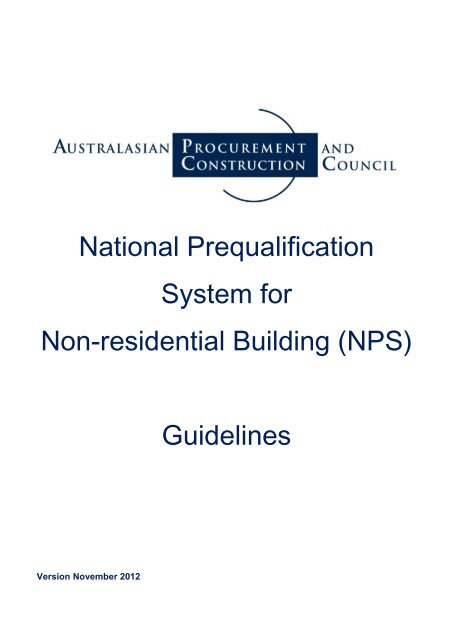
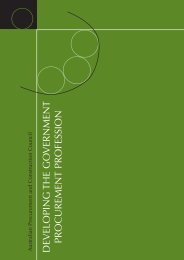
![NATIONAL COST ADJUSTMENT PROVISION EDITION 2 [NCAP2]](https://img.yumpu.com/48266135/1/184x260/national-cost-adjustment-provision-edition-2-ncap2.jpg?quality=85)
